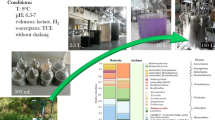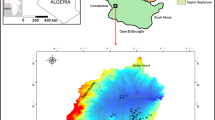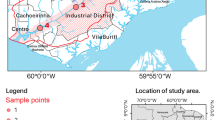Abstract
This study investigated the effects of hygiene indicator bacteria during the biostimulation of groundwater contaminated with chlorinated ethene. We showed the state of dechlorination activity and behavior of microbial structure by the addition of Escherichia coli (E. coli) as hygiene indicator bacteria in a contaminated groundwater sample. Dechlorination of tetrachloroethene and trichloroethene to cis-1,2-dichloroethene (cis-DCE) within 14 days took place similarly both with and without the addition of E. coli. This indicated that inhibition of against dechlorinating activity of corresponding dechlorinating bacteria was not caused by E. coli. Structural change of the bacterial community was analyzed both before and after dechlorination using a denaturing gradient gel electrophoresis (DGGE) and clone library. The result of DGGE detected E. coli only at day 0. A sample at day 14 after dechlorination detected Pseudomonas putida, Anaerosinus glycerini, and Clostridium genus but not E. coli. The result of the clone library also showed an identical profile. Detection of E. coli using desoxycholate media was decreased from 2.3 × 106 cells/ml to 6.0 × 103 cells/ml during day 14. These results suggest that biostimulation of groundwater contaminated by chlorinated ethene in the presence of hygiene bacteria caused the dechlorination without activity inhibition and decrease of dechlorinating bacteria.


Similar content being viewed by others
References
Agency for Toxic Substances and Disease Registry (1996) Toxicology profile for tetrachloroethylene (up-date), Atlanta
Ikeda M, Imanura T (1973) Biological half-life of trichloroethylene and tetrachloroethylene in human subjects. Int Arch Arbeitsmed 31:209–224
Beccari M, Majone M, Piemontese G, Tandoi V, Tomei MC (1998) Reductive dechlorination of tetrachloroethene by an anaerobic microbial consortium. Chim Ind 80:63–72
Agency for Toxic Substances and Disease Registry (2003) toxFAQsTM for trichloroethylene (TCE), Atlanta
Freedman DL, Gossett JM (1989) Biological reductive dechlorination of tetrachloroethylene and trichloroethylene to ethylene under methanogenic conditions. Appl Environ Microbiol 55:2144–2151
Loffler FE, Sanford RA, Tiedje JM (1996) Initial characterization of a reductive dehalogenase from Desulfitobacterium chlororespirans Co23. Appl Environ Microbiol 62:3809–3813
Holliger C, Hahn D, Harmsen H, Ludwig W, Schumacher W, Tindall B, Vazquez F, Weiss N, Zehnder AJ (1998) Dehalobacter restrictus gen. nov. and sp. nov., a strictly anaerobic bacterium that reductively dechlorinates tetra- and trichloroethene in an anaerobic respiration. Arch Microbiol 169:313–321
Utkin I, Woese C, Wiegel J (1994) Isolation and characterization of Desulfitobacterium dehalogenans gen. nov., sp. nov., an anaerobic bacterium which reductively dechlorinates chlorophenolic compounds. Int J Syst Bacteriol 44:612–619
Gerritse J, Renard V, Pedro Gomes TM, Lawson PA, Collins MD, Gottschal JC (1996) Desulfitobacterium sp. strain PCE 1, an anaerobic bacterium that can grow by reductive dechlorination of tetrachloroethene or ortho-chlorinated phenols. Arch Microbiol 165:132–140
Maillard J, Schumacher W, Vazquez F, Regeard C, Hagen WR, Holliger C (2003) Characterization of the corrinoid iron-sulfur protein tetrachloroethene reductive dehalogenase of Dehalobacter restrictus. Appl Environ Microbiol 69:4628–4638
Neumann A, Engelmann T, Schmitz R, Greiser Y, Orthaus A, Diekert G (2004) Phenyl methyl ethers: novel electron donors for respiratory growth of Desulfitobacterium hafniense and Desulfitobacterium sp. strain PCE-S. Arch Microbiol 181:245–249
Gerritse J, Drzyzga O, Kloetstra G, Keijmel M, Wiersum LP, Hutson R, Collins MD, Gottschal JC (1999) Influence of different electron donors and acceptors on dehalorespiration of tetrachloroethene by Desulfitobacterium frappieri TCE1. Appl Environ Microbiol 65:5212–5221
Krumholz LR (1997) Desulfuromonas chloroethenica sp. nov. uses tetrachloroethylene and trichloroethylene as electron acceptors. Int J Syst Bacteriol 47:1262–1263
Sung Y, Ritalahti KM, Sanford RA, Urbance JW, Flynn SJ, Tiedje JM, Löffler FE (2003) Characterization of two tetrachloroethene-reducing, acetate-oxidizing anaerobic bacteria and their description as Desulfuromonas michiganensis sp. nov. Appl Environ Microbiol 69:2964–2974
Sung Y, Fletcher KE, Ritalahti KM, Apkarian RP, Ramos-Hernández N, Sanford RA, Mesbah NM, Löffler FE (2006) Geobacter lovleyi sp. nov. strain SZ, a novel metal-reducing and tetrachloroethene-dechlorinating bacterium. Appl Environ Microbiol 72:2775–2782
Chang YC, Okeke BC, Hatsu M, Takamizawa K (2001) In vitro dehalogenation of tetrachloroethylene (PCE) by cell-free extracts of Clostridium bifermentans DPH-1. Bioresour Technol 78:141–147
Maymo-Gatell X, Anguish T, Zinder SH (1999) Reductive dechlorination of chlorinated ethenes and 1,2-dichloroethene by “Dehalococcoides ethenogenes” 195. Appl Environ Microbiol 65:3108–3113
Rahm BG, Chauhan S, Holmes VF, Macbeth TW, Sorenson KS, Alvarez-Cohen L (2006) Molecular characterization of microbial populations at two sites with differing reductive dechlorination abilities. Biodegradation 17:523–534
Sharma PK, McCarty PL (1996) Isolation and characterization of a facultatively aerobic bacterium that reductively dehalogenates tetrachloroethene to cis-1,2-dichloroethene. Appl Environ Microbiol 62:761–765
Lowe M, Madsen EL, Schindler K, Smith C, Emrich S, Robb F, Halden RU (2002) Geochemistry and microbial diversity of a trichloroethene-contaminated Superfund site undergoing intrinsic in situ reductive dechlorination. FEMS Microbiol Ecol 40:123–134
Miller TR, Franklin MP, Halden RU (2007) Bacterial community analysis of shallow groundwater undergoing sequential anaerobic and aerobic chloroethene biotransformation. FEMS Microbiol Ecol 60:299–311
Nemir A, David MM, Perrussel R, Sapkota A, Simonet P, Monier JM, Vogel TM (2010) Comparative phylogenetic microarray analysis of microbial communities in TCE-contaminated soils. Chemosphere 80:600–607
Macbeth TW, Cummings DE, Spring S, Petzke LM, Sorenson KS (2004) Molecular characterization of a dechlorinating community resulting from in situ biostimulation in a trichloroethene-contaminated deep, fractured basalt aquifer and comparison to a derivative laboratory culture. Appl Environ Microbiol 70:7329–7341
Bhowmik A, Asahino A, Shiraki T, Nakamura K, Takamizawa K (2009) In situ study of tetrachloroethylene bioremediation with different microbial community shifting. Environ Technol 30(14):1607–1614
Lee J, Lee TK, Löffler FE, Park J (2010) Characterization of microbial community structure and population dynamics of tetrachloroethene-dechlorinating tidal mudflat communities. Biodegradation 22:687–698
Aydin A (2007) The microbiological and physico-chemical quality of groundwater in West Thrace, Turkey; Polish. J Environ Stud 16(3):377–383
Bhowmik A, Ishimura K, Nakamura K, Takamizawa K (2012) Degradation activity of Clostridium species DC-1 in the cis-1,2-dichloroethylene contaminated site in the presence of indigenous microorganisms and Escherichia coli. J Mater Cycles Waste Manag
Annie R, Pierre S, Julia B, Marie R, Patrick L (2002) Detection and enumeration of coliforms in drinking water: current methods and emerging approaches. J Microbiol Methods 49:31–54
TA cloning protocol (2009) Durham: Hubbart Center for Genomic Studies
Hazen TC, Faybishenko B, Beller HR, Brodie EL, Sonnenthal EL, Steefel C, Larsen J, Conrad ME, Bill M, Christensen JN, Brown ST, Joyner D, Borglin SE, Geller JT, Chakraborty R, Nico PS, Long PE, Newcomer DR, Arntzen E (2011) The Smithsonian/NASA Astrophysics Data System. Comparison of field groundwater biostimulation experiments using polylactate and lactate solutions at the Chromium-Contaminated Hanford 100-H Site. American Geophysical Union, Fall Meeting
Altschul SF, Gish W, Miller W, Myers EW, Lipman DJ (1990) Basic local alignment search tool. J Mol Biol 215:403–410
Tamura K, Peterson D, Peterson N, Stecher G, Nei M, Kumar S (2011) MEGA5: molecular evolutionary genetics analysis using maximum likelihood, evolutionary distance, and maximum parsimony methods. Mol Biol Evol 28:2731–2739
Hata J, Miyata N, Kim E, Takamizawa K, Iwahori K (2004) Anaerobic degradation of cis-1,2-dichloroethylene and vinyl chloride by Clostridium sp. Strain DC-1 isolated from landfill leachate sediment. JBB 97(3):196–201
Kim E-S, Nomura I, Hasegawa Y, Takamizawa K (2006) Characterization of a newly isolated cis-1,2-dichloroethylene and aliphatic compound-degrading bacterium, Clostridium sp. Strain KYT-1. Biotechnol Bioprocess Eng 11:553–556
Andrew JW, Alison LW, Howard SJ (1982) Stereospecificity of 2-monochloropropionate dehalogenation by the two dehalogenases of Pseudomonas putida PP3: evidence for two different dehalogenation mechanisms. J Gen Microbiol 128(8):1755–1762
Garg SK, Tripathi M, Kumar S, Singh SK (2012) Microbial dechlorination of chloroorganics and simultaneous decolorization of pulp-paper mill effluent by Pseudomonas putida MTCC 10510 augmentation. Environ Monit Assess 184(9):5533–5544
Garg SK, Tripathi M, Singh SK, Singh A (2012) Pentachlorophenol dechlorination and simultaneous Cr(6+) reduction by Pseudomonas putida SKG-1 MTCC (10510): characterization of PCP dechlorination products, bacterial structure, and functional groups. Environ Sci Pollut Res Int
Moreau JW, Zierenberg RA, Banfield JF (2010) Diversity of dissimilatory sulfite reductase genes (dsrAB) in a salt marsh impacted by long-term acid mine drainage. Appl Environ Microbiol 76(14):4819–4828
Eva-Maria B, Sebastian B, Denise MA, Georg B, Kirsten K (2011) Heavy metal tolerance of Fe(III)-reducing microbial communities in contaminated creek bank soils. Appl Environ Microbiol 77(9):3132–3136
Flanigan D, Rodgers M (2003) A method to detect viable Helicobacter pylori bacteria in groundwater. Acta Hydrochim Hydrobiol 31(1):45–48
Maggy M, Veronica M, Jacques T (2006) Abundance of pathogenic Escherichia coli, Salmonella typhimurium and Vibrio cholerae in Nkonkobe drinking water sources. J Water Health 4(3):289–296
Frank J, Donald E, Douglas R (2002) PCR detection of specific pathogens in water: a risk-based analysis. Environ Sci Technol 36(12):2754–2759
Effect of Treatment on Nutrient Availability; EPA United States Environmental Protection Agency (2007). http://www.epa.gov/ogwdw/disinfection/tcr/pdfs/issuepaper_tcr_treatment-nutrients.pdf
Pieter TJ, Johnson AR, Townsend CC, Patricia MG, Robert WH, Valerie JM, Eliska R, Mary HW (2010) Linking environmental nutrient enrichment and disease emergence in humans and wildlife. Ecol Appl 20(1):16–29
http://www.dietrichidaho.com/public-works/idaho-rules-for-public-drinking-water-systems/idaho-rules-for-public-drinking-water-systems.pdf. Accessed 2 Feb 2013
http://www.deq.idaho.gov/water-quality/wastewater/septic-systems/nutrient-pathogen-evaluations.aspx. Accessed 2 Feb 2013
Rittmann BE (2004) Definition, objectives, and evaluation of natural attenuation. Biodegradation 15:349–357
Acknowledgments
We gratefully acknowledge Panasonic Environmental System and Engineering Co. Ltd, for providing groundwater sample used in this study. We also express our special thanks to Professor Fuseng Li, River Basin Research Center, Gifu University, for supporting part of this work.
Author information
Authors and Affiliations
Corresponding author
Rights and permissions
About this article
Cite this article
Arpita, B., Ishimura, K., Nakamura, K. et al. Microbial dynamics in the process of restoration of groundwater contaminated by chlorinated ethene in the presence of Escherichia coli . J Mater Cycles Waste Manag 15, 335–341 (2013). https://doi.org/10.1007/s10163-013-0124-y
Received:
Accepted:
Published:
Issue Date:
DOI: https://doi.org/10.1007/s10163-013-0124-y




